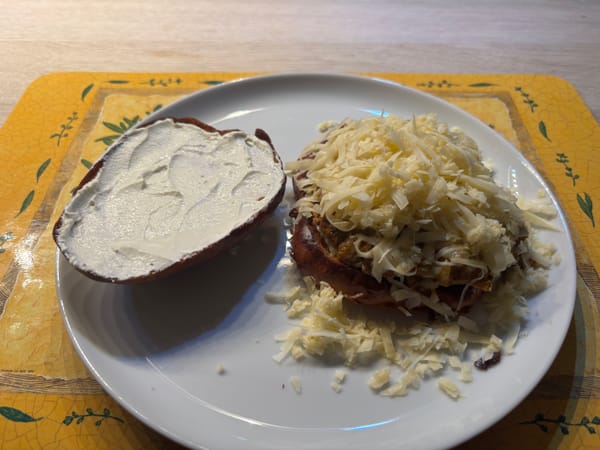Hello! Today we're going to take a look at some research, which shows us why the Mosaic Method can work, and which even might add a weapon to our arsenal in our fight against cancer.
There's something centrally important about cancer, that your doctors probably haven't told you – not out of malice, I daresay. And that is: Only a growing cancer kills. All measures against cancer, whether they be the standard of care, or our Mosaic Method aim to do one or both of:
- Increasing the death rate of cancer cells.
- Decreasing the growth rate of cancer cells.
Depending on how well we can achieve both these targets, cancer can even be fully cured. And isn't that just the dream of any cancer patient. Full disclosure, though, healing cancer is difficult, it's not always possible and our methods only improve as we learn more and more. And there's yet a lot to learn.
Iteratively improving our methods against cancer is precisely what we try to do at Marchward, along with helping cancer patients overcome and outlive their disease.
Increasing the death rate of cancer cells would be far easier, if we could just force cancer cells into suicide. Plus, understanding how this can be done, will also help us understand why the Mosaic Method works.
The Mosaic Method stands somewhat at odds with the mainstream understanding of cancer. Not so with the literature, but with common medical practice. One of the primary reasons for this is the common misconception of cancer as a primarily genetic disease. This has been found to be untrue over the last two-ish decades (1–6).
We publish new articles, whenever we've synthesised new findings to a usable degree. You can subscribe to receive articles for free.
I've written on this fact in more detail in the prior post 'How Our Dad Is Outliving Cancer', so I won't go into too much depth here, but let's still refresh our memory.
Common medical practice holds cancer to be a disease caused by degeneracies in the genome of the cell. The genome is found in the nucleus of a cell. And experiments, which transplanted cancerous nuclei into healthy (denucleated) cells, found that the cancerous nucleus itself had no power to turn the cell cancerous. Interestingly transplanting a healthy nucleus into a cancerous (denucleated) cell gave rise to a cancer cell (7).
This means, that the nucleus and thus genome aren't primary drivers of cancer, but the rest of the cell's inner volume is. This rest of the cell's inner volume is termed cytosol and contains the bulk of cell metabolism. In cancer cells, mitochondria – structures of the cytosol – are especially degenerate. Mitochondria house the bulk of healthy energy metabolism, which uses oxygen, and also play an indispensable role in monitoring cell health and initiating cell death, when the cell has become defective.
The entire logic behind our Mosaic Method is to force cancer cells to heal their mitochondria, or at least activate them enough, so that they can force the cancer cell into suicide.
But is this logic even sound? Does forcing mitochondrial energy metabolism in cancer cells actually lead to lower cancer cell proliferation and higher cell death rates? It would be very simple to test this query, if we had a pharmaceutical compound, which can force or promote mitochondrial energy metabolism (called 'oxidative phosphorylation', henceforth 'oxphos').
Interestingly, such as compound is known and it's being researched for precisely this purpose.
The compound in question is called dichloroacetate (DCA).
DCA has been shown in multiple studies and in multiple cell lines and animal models to inhibit cancer cell growth (8–10). The mechanism behind this seems to be a promotion of oxphos over glycolysis (the preferred energy metabolism of various cancer cells for various reasons). As a lot of cancer cell types have compromised mitochondria and thus heavily compromised oxphos, a promotion of oxphos over glycolysis can lead to an energy deficit within the cancer cell, thus killing it. This shows us, that promoting mitochondrial metabolism can actually negatively impact cancer cells selectively, which is one of the basic premisses of the Mosaic Method.
We don't take sponsoring or display advertisements in order to keep us free from conflicts of interest. If you've found this valuable, you can help us by supporting our fight against cancer financially.
It's also for this purpose, that DCA is being heavily researched (11). Since it has shown adverse effects against peripheral nervous cells, I would recommend not to use DCA itself, but use other methods of achieving the same effect. Whilst there is theoretical merit to DCA being somewhat more tolerable in a priorly fat-adapted individual, the literature is lacking in this regard. Furthermore, DCA also interferes with a variety of other metabolic pathways, so using DCA is decidedly not recommendable, before we know more.
Luckily, we can achieve similar effects with far fewer (if any) side effects. We can promote oxphos over glycolysis simply by providing less glucose and more fat. This is easily done with a high-fat, carbohydrate-exclusionary diet.
And if you've paid attention to the seven steps of the Mosaic Method, you know that such a high-fat, carbohydrate-exclusionary diet is part of the method (marked in bold):
- eliminate all carbohydrates
- eliminate all glutamine and glutamate
- maximise fat consumption
- supplement vitamin D3 and omega-3 fatty acids
- supplement EGCG and curcumin
- eliminate alcohol, oxalates, and other pro-inflammatory substances
- keep a positive mind
Still, you may be sceptical, whether a dietary change can bring about similar effects to DCA. Luckily for us, the ketogenic diet is being researched in its potential to treat cancer, and has shown promise in mice and humans even against highly aggressive cancers despite subpar implementation (12–16). By subpar implementation I here mean the use of seed oils in the 'ketogenic formulations' and the incomplete elimination of carbohydrates from the same.
I predict, that a fully carbohydrate-exclusionary, high-fat diet would work even better, but the basic concept is still proven right. Dietary intervention can have an enormous impact on cancer growth and disease progression. A big problem in studies researching dietary intervention against cancer is poor patient adherence to the intervention. I find this insane, given the severity of cancer as a disease and the comparative triviality of a dietary change, but alas, humans are creatures of habit.
May you be flexible enough to heal yourself, for everything looks like you can, if only you're willing to sacrifice.
Good health and healing to you,
Merlin.
References
- Alfarouk, K.O. (2016). Tumor metabolism, cancer cell transporters, and microenvironmental resistance. Journal of Enzyme Inhibition and Medicinal Chemistry 31, 859-866. 10.3109/14756366.2016.1140753.
- Alfarouk, K.O., Shayoub, M.E.A., Muddathir, A.K., Elhassan, G.O., and Bashir, A.H.H. (2011). Evolution of Tumor Metabolism might Reflect Carcinogenesis as a Reverse Evolution process (Dismantling of Multicellularity). Cancers 3, 3002-3017.
- Poff, A.M., Ari, C., Arnold, P., Seyfried, T.N., and D'Agostino, D.P. (2014). Ketone supplementation decreases tumor cell viability and prolongs survival of mice with metastatic cancer. International Journal of Cancer. Journal International du Cancer 135, 1711 - 1720.
- Seyfried, T.N., Arismendi-Morillo, G.J., Mukherjee, P., and Chinopoulos, C. (2020). On the Origin of ATP Synthesis in Cancer. iScience 23.
- Seyfried, T.N., and Huysentruyt, L.C. (2013). On the origin of cancer metastasis. Critical reviews in oncogenesis 18 1-2, 43-73.
- Seyfried, T.N., and Shelton, L.M. (2010). Cancer as a metabolic disease. Nutrition & Metabolism 7, 7 - 7.
- Seyfried, T.N., and Chinopoulos, C. (2021). Can the Mitochondrial Metabolic Theory Explain Better the Origin and Management of Cancer than Can the Somatic Mutation Theory? Metabolites 11.
- Bonnet, S., Archer, S.L., Allalunis-Turner, J., Haromy, A., Beaulieu, C., Thompson, R., Lee, C.T., Lopaschuk, G.D., Puttagunta, L., Bonnet, S., et al. (2007). A Mitochondria-K+ Channel Axis Is Suppressed in Cancer and Its Normalization Promotes Apoptosis and Inhibits Cancer Growth. Cancer Cell 11, 37-51. 10.1016/j.ccr.2006.10.020.
- Lam, S.-K., Yan, S., Lam, J.S.-M., Feng, Y., Khan, M., Chen, C., Ko, F.C.-F., and Ho, J.C.-M. (2022). Disturbance of the Warburg effect by dichloroacetate and niclosamide suppresses the growth of different sub-types of malignant pleural mesothelioma in vitro and in vivo. Frontiers in Pharmacology 13. 10.3389/fphar.2022.1020343.
- Stockwin, L.H., Yu, S.X., Borgel, S., Hancock, C., Wolfe, T.L., Phillips, L.R., Hollingshead, M.G., and Newton, D.L. (2010). Sodium dichloroacetate selectively targets cells with defects in the mitochondrial ETC. Int J Cancer 127, 2510-2519. 10.1002/ijc.25499.
- Tataranni, T., and Piccoli, C. (2019). Dichloroacetate (DCA) and Cancer: An Overview towards Clinical Applications. Oxid Med Cell Longev 2019, 8201079. 10.1155/2019/8201079.
- Poff, A.M., Ari, C., Arnold, P., Seyfried, T.N., and D'Agostino, D.P. (2014). Ketone supplementation decreases tumor cell viability and prolongs survival of mice with metastatic cancer. International Journal of Cancer. Journal International du Cancer 135, 1711 - 1720.
- Poff, A.M., Ari, C., Seyfried, T.N., and D'Agostino, D.P. (2013). The Ketogenic Diet and Hyperbaric Oxygen Therapy Prolong Survival in Mice with Systemic Metastatic Cancer. PLoS One 8.
- Seyfried, T.N., Flores, R., Poff, A.M., D’Agostino, D.P., and Mukherjee, P. (2015). Metabolic therapy: A new paradigm for managing malignant brain cancer. Cancer Letters 356, 289-300. https://doi.org/10.1016/j.canlet.2014.07.015.
- Weber, D.D., Aminzadeh-Gohari, S., Thapa, M., Redtenbacher, A.-S., Catalano, L., Capelôa, T., Vazeille, T., Emberger, M., Felder, T.K., Feichtinger, R.G., et al. (2022). Ketogenic diets slow melanoma growth in vivo regardless of tumor genetics and metabolic plasticity. Cancer & Metabolism 10, 12. 10.1186/s40170-022-00288-7.
- Haskins, C., Cohen, J., Kotecha, R., and Kaiser, A. (2021). Low Carbohydrate Diets in Cancer Therapeutics: Current Evidence. Frontiers in Nutrition 8. 10.3389/fnut.2021.662952.









